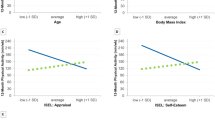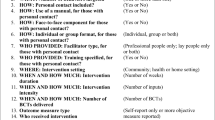Abstract
Background: Limited evidence exists on long-term efficacy of interactive computer-tailored interventions for increasing physical activity and decreasing fat intake, and even more so when they are implemented simultaneously or sequentially.Purpose: This study aims to examine long-term efficacy of interactive computer-tailored physical activity and fat intake interventions, and evaluate their efficacy in a simultaneous or sequential implementation over 2 years.Methods: Participants (392) were randomly assigned to a simultaneous group receiving both interventions at baseline; a sequential group first receiving the physical activity intervention and 3 months later the fat intake intervention; and a sequential group first receiving the fat intake intervention and 3 months later the physical activity intervention.Results: Strong time effects were seen for total physical activity (F=38.7, p<.001) and fat intake (F=103.9, p<.001), indicating that intervention effects remained over 2 years for those participants that were still available for the 2-year follow-up. At 2-year follow-up the interventions resulted in a 10% and a 27% increase of participants that met public health recommendations for physical activity and fat intake, respectively. Overall the interventions were more effective for participants not meeting the public health recommendations at baseline. The sequential intervention mode was overall slightly more effective than the simultaneous mode in maintaining intervention effects.Conclusions: Both interventions showed efficacy in maintaining long-term health behavior changes. More research is needed on sequential and simultaneous intervening modes.
Similar content being viewed by others
References
Vandelanotte C, De Bourdeaudhuij I, Sallis JF, et al.: Efficacy of sequential or simultaneous interactive computer-tailored interventions for increasing physical activity and decreasing fat intake.Annals of Behavioural Medicine. 2005,29:138–146.
Kroeze W, Werkman A, Brug J: A systematic review of randomized trials on the effectiveness of computer-tailored education on physical activity and dietary behaviours.Annals of Behavioural Medicine. 2006,31:205–223.
Marcus BH, Owen N, Forsyth LH, et al.: Physical activity interventions using mass media, print media, and information technology.American Journal of Preventive Medicine. 1998,15:362–378.
Napolitano MA, Marcus BH: Targeting and tailoring physical activity information using print and information technologies.Exercise and Sport Sciences Reviews. 2002,30:122–128.
Bock BC, Marcus BH, Pinto BM, Forsyth LH: Maintenance of physical activity following an individualized motivationally tailored intervention.Annals of Behavioral Medicine. 2001,23:79–87.
Vandelanotte C, De Bourdeaudhuij I: Acceptability and feasibility of a computer-tailored physical activity intervention using stages of change: Project FAITH.Health Education Research. 2003,18:304–317.
Vandelanotte C, De Bourdeaudhij I, Brug J: Acceptability and feasibility of an interactive computer-tailored fat intake intervention in Belgium.Health Promotion International. 2004,19:463–470.
U.S. Department of Health and Human Services:Physical Activity and Health: A Report of the Surgeon General. Atlanta, GA: Centers for Disease Control and Prevention, National Center for Chronic Disease Prevention and Health Promotion, 1996.
Krauss RM, Deckelbaum RJ, Ernst N, et al.: Dietary guidelines for healthy American adults. A statement for health professionals from the nutrition committee and American Heart Association.Circulation. 1996,94:1795–1800.
Vandelanotte C, De Bourdeaudhuij I, Philippaerts R, et al.: Reliability and validity of a computerized and dutch version of the International Physical Activity Questionnaire (IPAQ).Journal of Physical Activity and Health. 2005,2:63–75.
Craig CL, Marshall AL, Sjostrom M, et al.: International physical activity questionnaire: 12-country reliability and validity.Medicine and Science in Sports and Exercise. 2003,35:1381–1395.
Vandelanotte C, Matthys C, De Bourdeaudhij I: Reliability and validity of a computerised questionnaire to measure fat intake in Belgium.Nutrition Research. 2004,24:621–631.
Author information
Authors and Affiliations
Corresponding author
Additional information
This study was fully financially supported by the Ghent University and the Flemish Fund for Scientific Research. Intervention development and all research was done at the Ghent University.
Corneel Vandelanotte affiliation was previously at the Ghent University in Belgium and recently changed to the University of Queensland in Australia.
About this article
Cite this article
Vandelanotte, C., De Bourdeaudhuij, I. & Brug, J. Two-year follow-up of sequential and simultaneous interactive computer-tailored interventions for increasing physical activity and decreasing fat intake. ann. behav. med. 33, 213–219 (2007). https://doi.org/10.1007/BF02879903
Issue Date:
DOI: https://doi.org/10.1007/BF02879903




